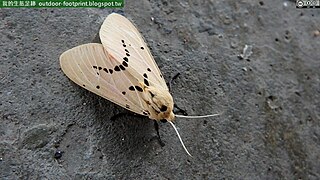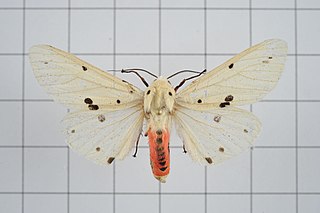
The buff ermine is a moth of the family Erebidae. It is sometimes placed in the genus Spilosoma. The species was first described by Johann Siegfried Hufnagel in 1766. It is found throughout the temperate belt of the Palearctic region south to northern Turkey, Georgia, Kazakhstan, southern Siberia, eastern Mongolia, Amur Region, China, Korea and Japan.

The Spilosomina are a subtribe of tiger moths in the tribe Arctiini, which is part of the family Erebidae.

Spilarctia is a genus of moths in the family Erebidae. The genus was erected by Arthur Gardiner Butler in 1875.
Spilarctia todara is a moth of the family Erebidae. It was described by Frederic Moore in 1872. It is found in eastern India.
Spilarctia bisecta is a moth in the family Erebidae. It was described by John Henry Leech in 1889. It is found in China.
Spilarctia leopardina is a moth in the family Erebidae. It was described by Vincenz Kollar in 1844. It is found in Tibet, Nepal, the north-western Himalayas and Kashmir.
Spilarctia melanostigma is a moth in the family Erebidae. It was described by Nikolay Grigoryevich Erschoff in 1872. It is found in Uzbekistan, Kyrgyzstan, Hissar, Pamirs, Afghanistan, Pakistan and from the Himalayas to Sikkim and Assam.
Spilarctia seriatopunctata is a moth in the family Erebidae. It was described by Motschulsky in 1861. It is found in Russia, China, Korea and Japan.
Spilarctia nydia is a moth in the family Erebidae. It was described by Arthur Gardiner Butler in 1875. It is found in Nepal, China, Taiwan and northern Vietnam.

Spilarctia alba is a moth in the family Erebidae. It was described by Otto Vasilievich Bremer and William Grey in 1853. It is found in China, Taiwan and Korea.
Spilarctia bipunctata is a moth in the family Erebidae. It was described by Franz Daniel in 1943. It is found in Yunnan and Sichuan in China.
Spilarctia comma is a moth in the family Erebidae. It was described by Francis Walker in 1856. It is found in Tibet in China and in Bhutan.
Spilarctia longiramia is a moth in the family Erebidae. It was described by George Hampson in 1901. It is found on Java and Sumatra.
Spilarctia mona is a moth in the family Erebidae. It was described by Charles Swinhoe in 1885. It is found in southern India.
Spilarctia novaeguineae is a moth in the family Erebidae. It was described by Walter Rothschild in 1913. It is found in Papua New Guinea.
Spilarctia sparsalis is a moth in the family Erebidae. It was described by Francis Walker in 1865. It is found on Sulawesi.

Spilarctia subcarnea is a moth in the family Erebidae. It was described by Francis Walker in 1855. It is found in Nepal, China, the Russian Far East, Korea, Japan and Taiwan.
Spilarctia cervina is a moth in the family Erebidae. It was described by Hans Daniel Johan Wallengren in 1860. It is found on Sumatra and the Mentawai Islands of Indonesia.
Spilarctia griseabrunnea is a moth in the family Erebidae. It was described by Jeremy Daniel Holloway in 1976. It is found on Borneo. The habitat consists of disturbed areas, agricultural areas and secondary vegetation ranging from the lowlands to altitudes of 1,200 meters.




